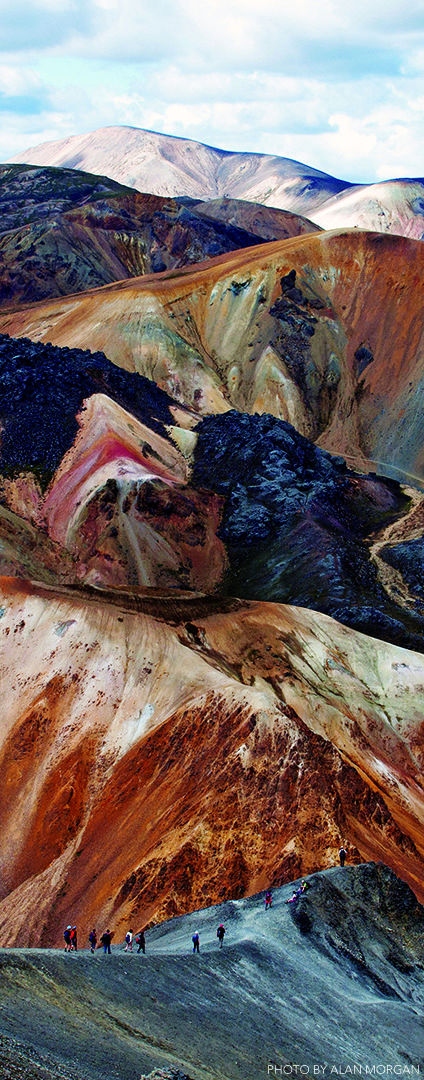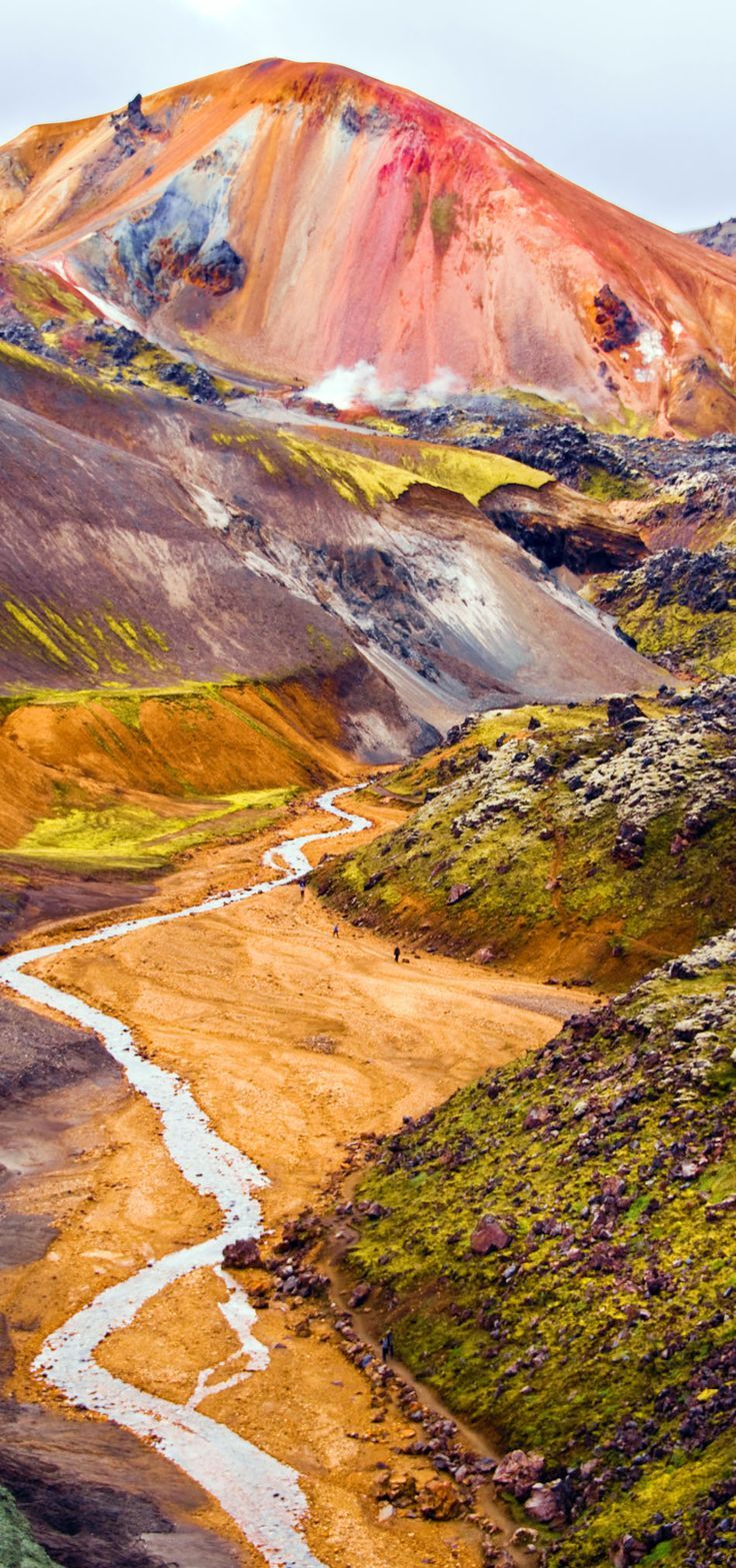In A First, Scientists Have Discovered That The Marine Algal Species Nannochloropsis Oceanica Can Live

In a first, scientists have discovered that the marine algal species Nannochloropsis oceanica can live inside the fungus Mortierella elongata. The species formed a mutually beneficial relationship in a lab dish.
More Posts from Rocks-everywhere and Others


Iceland: Landmannalaugar, Suðurland

Heidi Gustafson, who has spent the past five years collecting and working with ocher, walks along Whidbey Island’s Double Bluff Beach, off the coast of Washington, in search of the material. She came to scout this area, where she spent time as a child, after recalling its interesting cliff exposure.Some ochers, Gustafson believes, are calling out to be turned into a pigment. Others are more resistant. Those ocher fragments are either returned to their point of origin, or, if Gustafson cannot get back there, placed outside in a stone graveyard of sorts that she has created in the forest near her cabin. A few of her ocher-based artworks hang on the wall.
https://www.nytimes.com/2019/10/24/t-magazine/ocher-heidi-gustafson.html










I miss doing microscope work. Can we make a thread of our favourite thin section? This is mine
Actinolite Schist

As cat owners we like to joke about how the cat is the one who’s really in charge, but let’s be honest here: my cats think they’re in charge, but they’re also fucking dumbasses. It’s sort of an incompetent-king-and-long-suffering-advisor arrangement, if the king were prone to getting their head stuck in Kleenex boxes.

What if... what if I WANT an info dump???
Then you're my favorite and I will dump SO much info on natrocarbonatite lava
No one knows for sure why or how this type of lava forms. Oldoinyo Lengai is the only volcano on earth that actively erupts it currently, and Oldoinyo Lengai hasn't been extensively studied.
The factor that causes lava to be viscous (thick, and sticky) is its silica content. Rhyolitic magmas, like those in Washington, have around 70 weight % silica. Basaltic magmas, like the volcanoes in Hawai'i, are around 45 wt% silica. Natrocarbonatite lava is less than 3% silica. Its flow rate is close to water, so it flows faster than you can outrun.
It's also a LOT less hot than other lavas. Most lavas are from 700-1200 degrees C (basaltic lavas in the higher range, rhyolitic lavas in the lower), but natrocarbonatite is around 500-600 degrees C. It's cool enough that you won't immediately die if you fall into it (you'll be hospitalized for months, as one man who fell into it was, but it's survivable). It's so cool that you can't see it glow in daylight.

It flows black and cools white! This is because of its content of the minerals nyerereite and gregoryite, which are unstable and break down quickly when exposed to humidity.
Basically it's cool as fuck literally and figuratively and I'm obsessed with it



A Rainbow of Light Diffracts Through Hummingbird Wings in Photographs by Christian Spencer
The American Museum of Natural History takes you along on a dinosaur dig in the Morrison Formation of the US west, host of many of the famous Jurassic dinosaur bones found in North America.
-
 hylongcat liked this · 1 year ago
hylongcat liked this · 1 year ago -
 chirpchirrup liked this · 4 years ago
chirpchirrup liked this · 4 years ago -
 wondering-oracle liked this · 5 years ago
wondering-oracle liked this · 5 years ago -
 i-have-approximately-4-bones reblogged this · 5 years ago
i-have-approximately-4-bones reblogged this · 5 years ago -
 moominland reblogged this · 5 years ago
moominland reblogged this · 5 years ago -
 billyeverydayuniverse liked this · 5 years ago
billyeverydayuniverse liked this · 5 years ago -
 charlesonmambo reblogged this · 5 years ago
charlesonmambo reblogged this · 5 years ago -
 scientistjose liked this · 5 years ago
scientistjose liked this · 5 years ago -
 edwordsmyth liked this · 5 years ago
edwordsmyth liked this · 5 years ago -
 moominland liked this · 5 years ago
moominland liked this · 5 years ago -
 hc1701 liked this · 5 years ago
hc1701 liked this · 5 years ago -
 foxjevilwild liked this · 5 years ago
foxjevilwild liked this · 5 years ago -
 roachliquid reblogged this · 5 years ago
roachliquid reblogged this · 5 years ago -
 storiesintheashes liked this · 5 years ago
storiesintheashes liked this · 5 years ago -
 robinrobot reblogged this · 5 years ago
robinrobot reblogged this · 5 years ago -
 robinrobot liked this · 5 years ago
robinrobot liked this · 5 years ago -
 charlesonmambo liked this · 5 years ago
charlesonmambo liked this · 5 years ago -
 mystrade4ever liked this · 5 years ago
mystrade4ever liked this · 5 years ago -
 squirrellythief reblogged this · 5 years ago
squirrellythief reblogged this · 5 years ago -
 grendels-mother liked this · 5 years ago
grendels-mother liked this · 5 years ago -
 thundrhamr reblogged this · 5 years ago
thundrhamr reblogged this · 5 years ago -
 whovianuncle reblogged this · 5 years ago
whovianuncle reblogged this · 5 years ago -
 zarahdays liked this · 5 years ago
zarahdays liked this · 5 years ago -
 5bbe52 reblogged this · 5 years ago
5bbe52 reblogged this · 5 years ago -
 droidmom liked this · 5 years ago
droidmom liked this · 5 years ago -
 golden-poppy-crafts liked this · 5 years ago
golden-poppy-crafts liked this · 5 years ago -
 pleasespellchimerical reblogged this · 5 years ago
pleasespellchimerical reblogged this · 5 years ago -
 tinsnip reblogged this · 5 years ago
tinsnip reblogged this · 5 years ago -
 tinsnip liked this · 5 years ago
tinsnip liked this · 5 years ago -
 silentgong reblogged this · 5 years ago
silentgong reblogged this · 5 years ago -
 silentgong liked this · 5 years ago
silentgong liked this · 5 years ago -
 swamp-milkweed liked this · 5 years ago
swamp-milkweed liked this · 5 years ago -
 thereal-beanbean reblogged this · 5 years ago
thereal-beanbean reblogged this · 5 years ago -
 thereal-beanbean liked this · 5 years ago
thereal-beanbean liked this · 5 years ago -
 mangy-mongrel liked this · 5 years ago
mangy-mongrel liked this · 5 years ago -
 rocks-everywhere reblogged this · 5 years ago
rocks-everywhere reblogged this · 5 years ago -
 good-night-space-kid liked this · 5 years ago
good-night-space-kid liked this · 5 years ago -
 mushroomsandmicroscopes reblogged this · 5 years ago
mushroomsandmicroscopes reblogged this · 5 years ago -
 nerdyguy94 liked this · 5 years ago
nerdyguy94 liked this · 5 years ago -
 ennuijpg liked this · 5 years ago
ennuijpg liked this · 5 years ago -
 lovelyardie liked this · 5 years ago
lovelyardie liked this · 5 years ago -
 micromultiverse reblogged this · 5 years ago
micromultiverse reblogged this · 5 years ago -
 cthulhubert reblogged this · 5 years ago
cthulhubert reblogged this · 5 years ago -
 deltaperseii liked this · 5 years ago
deltaperseii liked this · 5 years ago -
 micromultiverseadmin liked this · 5 years ago
micromultiverseadmin liked this · 5 years ago
225 posts
